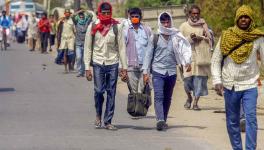If We Can See Trash Mountains, Why Are Waste-Pickers Invisible?
There are mountains in the middle of Delhi if you haven’t noticed. No, these are not the ones Delhiites left for whenever coronavirus lockdowns eased. Nor do they produce the ‘fresh’ air that the city’s inhabitants move out in search of. The tallest of these are the mountains of garbage in Ghazipur. According to a Newslaundry report, this “dumpsite, which was 65 metres tall [in late 2019], had the infamous record of being just a few metres short of the Qutub Minar, which is 73 metres high”.
Can this naked proof of the colossal failure of waste management not be evident to the government? What makes our dumpsites grow inch by inch every day? And if such sites emanate foul smells, and the waste reacts on-site to release toxic gases and occasional fires, who is responsible for this pollution and risk to life?
Saumya Roy, a Mumbai-based journalist-activist and co-founder of Vandana Foundation, which supports micro-entrepreneurs, provides a holistic account of the city’s Deonar trash township in her book, Mountain Tales: Love and Loss in the Municipality of Castaway Belongings (Profile Books, 2021). She effectively depicts the neglect of successive governments, hooliganism of land mafias, and the risky lives that waste-pickers confront in landfill townships.
Roy first met the waste-pickers of Deonar in 2013. While running the micro-finance firm that loaned them money, she began to take an interest in other aspects of their lives. She notes that nowhere in the Mumbai slums where her firm worked “did repayments come in as unfailingly as they did from the ones around the Deonar mountains”. However, that suddenly changed, as people began facing severe hardships and restrictions from the authorities, making it impossible to pick waste, earn money, and thus repay loans.
It is Farzana’s story that stands out in Mountain Tales, though the book is about much more. It is a deeply researched work that traces the mention of ‘trash trains’ that arrived at the Deonar grounds to the 1890s. Though research work can tend to demonstrate absolute authority, Roy balances it out with an empathetic tone. She tells the stories of the families of ragpickers, and in doing so, puts forth the more critical questions that have remained unanswered for decades. For example, who owns the garbage that gets cleared? Why do ragpickers demand identity cards and the status of this demand? Is the right to life of ragpickers not betrayed by their living conditions?
Several cases have been filed in the Mumbai courts to investigate and hold municipalities and agencies involved in ‘clearing’ garbage-dumping grounds accountable. But their outcomes have resulted in more problems than providing solutions. One such firm was Tatva, which did more damage than it repaired in the township.
Justice Oka, who presided over most of the hearings related to trash township matters, and came down hard on Tatva, had observed in 2016 that “the municipality had allowed reckless construction and development in Mumbai, without thinking of its mounting flow of trash and the reeking township that it emptied into.” [As an aside, in November that year, Prime Minister Narendra Modi declared notes of Rs. 500 and Rs. 1,000 illegal tender and a mountain of cash would arrive at this township! “Pickers sold them for less than the printed amount, before guards and policemen blocked their entry to the mountains,” notes Roy.]
But trash townships aren’t a unique problem for India. Towards the end of the book, Roy mentions visiting the Fresh Kills garbage township in New York. “It was a garbage city so vast that there were traffic lights to direct trash caravans through its towering garbage hills,” she writes.
While the privileged keep garbage outside of ‘home,’ some dumping grounds are home to people who are invisibilised. The waste-pickers at Deonar realised (though only after an immensely horrific tragedy befell Farzana) that if they remain invisible for far too long, then their lives would not matter at all. Now, the “pickers...wanted identity cards to make them exist officially,” writes Roy. Meanwhile, court cases related to the township kept piling up. Notably, Justice Oka pointed out that the “real challenge before our legal system is not of docket [legal case file] explosion but of docket exclusion.” Though trash mountains can be seen with the naked eye, can “people like Farzana and those in Karvale [a village in Palghar district]” be visibilised in the same manner in the courts, Oka asked.
Almost every year, a new finding or report presents shocking figures about India’s dumping grounds. According to one report, some of these mountains have risen to a height of 120 feet and “hydrogen sulphide, a poisonous flammable gas known for its rotten-egg smell, had more than tripled between 2010 and 2015, as had methane, feeding the ever-burning fires. Carbon monoxide, which could cause headaches and dizziness, was five times higher”. Another report estimated that “the city [of Delhi] generated around 9,000 tonnes of garbage every day.” Strangely, no such reports mentioned the lives of people living in these townships nor presented a keen interest in their lives and rights. And that is the gap that Roy fills with Mountain Tales.
The author is an independent journalist. The views are personal.
Get the latest reports & analysis with people's perspective on Protests, movements & deep analytical videos, discussions of the current affairs in your Telegram app. Subscribe to NewsClick's Telegram channel & get Real-Time updates on stories, as they get published on our website.
























